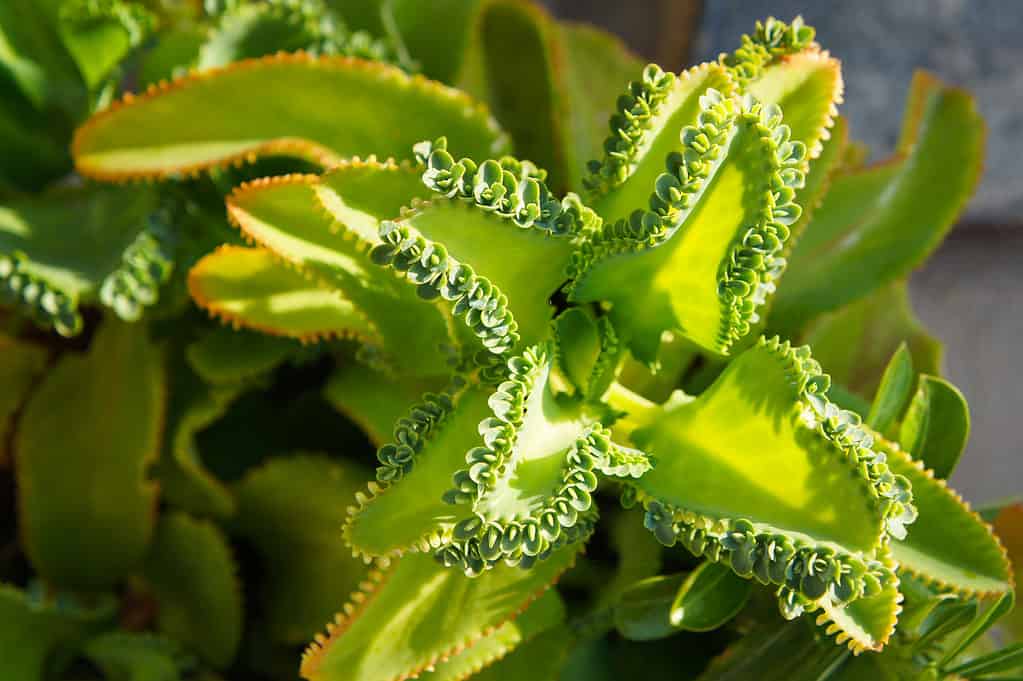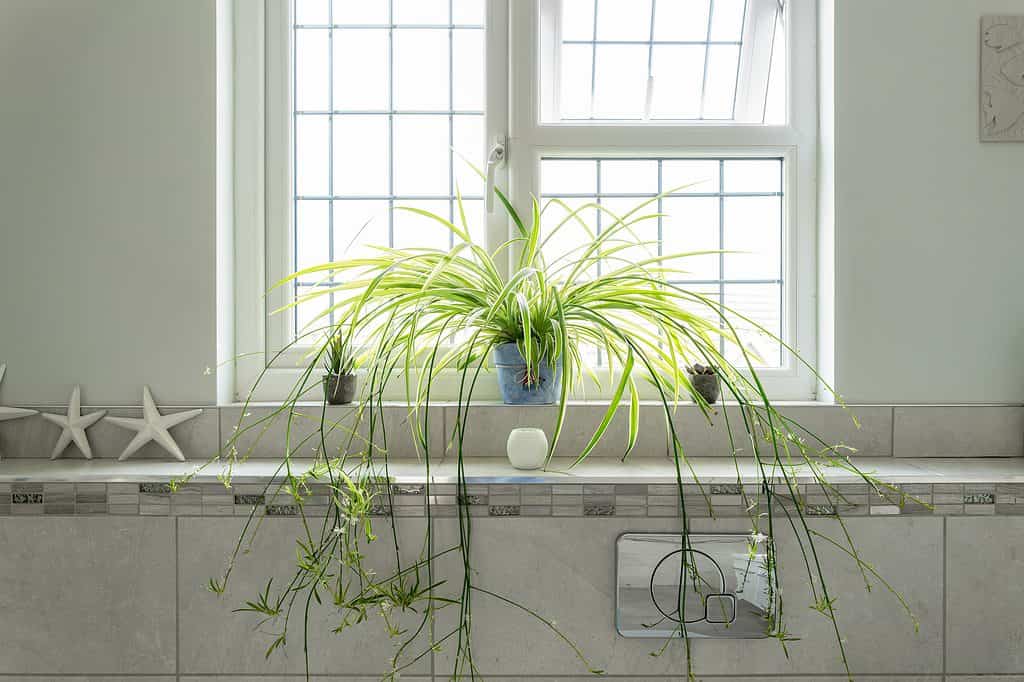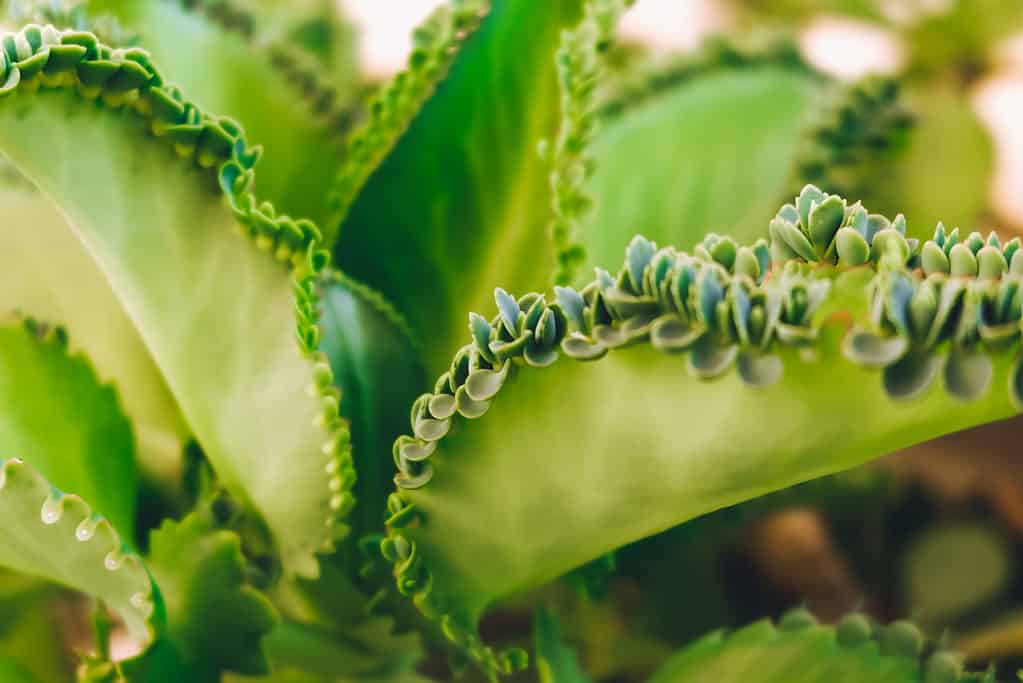Commonly known as the mother of thousands plant, the Kalanchoe daigremontiana (formerly known as Bryophyllum daigremontianum), is an easy-to-care-for indoor succulent.
The plant has some specific light requirements, though, so learning the proper care for this unique and intriguing plant will help you keep it thriving with little effort.

The plant needs bright, indirect light for 6 hours a day.
©iStock.com/skymoon13
Quick Facts About the Mother of Thousands Plant
- The unique plant is a self-propagating plant. Those little growths on the edges of the leaves are actually baby plants. This is part of why light specifications are so important – you don’t want to scorch those babies!
- The plant has several nicknames, as well, such as Alligator plant, Mexican hat plant, or Devil’s backbone. Most commonly, it is referred to as the mother of thousands because it literally produces thousands of plantlets without help from humans.
- It’s extremely rare for indoor mother of thousands to produce flowers. Instead, their foliage and the unique look of the plantlets make them popular houseplants.
- Mother of thousands plants are toxic. They should only handled with gloves and should be kept away from children and animals.
- The plant is native to arid portions of Madagascar. It has been introduced around the world, though, in similar environments.
- The plant typically grows to about 3 feet in height.
To learn more about the mother of thousands plant, please check out our full care guide, the watering guide, the propagation guide, meaning of the plant, hanging planter ideas, tips for growing the plant indoors and the plant’s profile.
Light Requirements for Mother of Thousands

Ideally, a setup like this would work for your plant – an easterly facing window with diffused light.
©Nick Beer/Shutterstock.com
Now that you know a little about this plant’s basic needs and intriguing realities, let’s look through the specific lighting needs. Watering and lighting are the trickiest parts of care for the mother of thousands. But if you can get those down, you’ll have thriving succulents for years to come.
Provide the Mother of Thousands with Bright, Indirect Light
Lighting needs of the mother of thousands is clear: they need bright, indirect light. If you happen to live in a temperate region, you may well achieve this outdoors by placing the plant where it will receive partial light in the morning with diffused light the rest of the day.
Most of us, however, have to grow this plant indoors to meet the temperature requirements of 65- to 75-degrees F. Indoors, the temperature is much easier to maintain, but the lighting can be a bit more difficult.
The best location for the plant will be in an easterly facing window, a little away from the window to avoid heat from the sun. The second choice would be a westerly or southerly-facing window, a few feet away. Avoid northerly-facing windows, if at all possible. If you only have a northerly facing window, ensure the plant is away from the window to avoid burning the plant.
If your window situation isn’t ideal, it’s recommended that you use grow lights to keep the plant healthy and happy while growing indoors.
Provide the Plant With 6 Hours of Light Daily

Mother of thousands will thrive in bright, indirect light, with occasional watering.
©iStock.com/PUGUN SJ
Additionally, the plant requires about 6 hours of that indirect, bright light. This is, again, often where grow lights come into play. This is particularly true if the sky is overcast or it’s wintertime when daylight hours are shorter.
If you use grow lights, be sure that they are LED lights. They don’t add heat and can be controlled more easily. You can change settings to turn the lights on at specific hours of the day or night, dim or brighten naturally like the world outdoors, and provide the plant with full-spectrum lighting, which will help its health overall.
How to Adapt Full Sun to Partial Shade Indoors or Out
If your setting isn’t ideal for the plant, there are a few ways to adapt to partial shade and diffused light for your mother of thousands plant.
- Provide a shade cloth outdoors – this can be staked, hung, or otherwise provided through various means.
- Use sheer, light-colored curtains on your windows to diffuse light for indoor plants
- Add outdoor curtains and keep the plant on the patio or balcony or in the gazebo
- Provide a shade screen made of light cloth to allow light through without all the direct heat
- Use a greenhouse setting indoors or outdoors, if light becomes an issue. The walls of the greenhouse naturally diffuse light.
The photo featured at the top of this post is © iStock.com/skymoon13
Thank you for reading! Have some feedback for us? Contact the AZ Animals editorial team.







